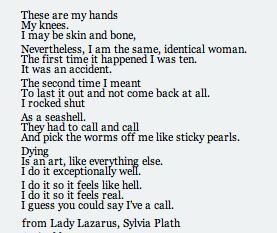 | ||
Similar Works by Sylvia Plath, Other books | ||
Sylvia plath reads lady lazarus
"Lady Lazarus" is a poem written by Sylvia Plath, originally collected in the posthumously published volume Ariel and commonly used as an example of her writing style.
Contents
- Sylvia plath reads lady lazarus
- Lady lazarus read by sylvia plath
- Allusions to World War II
- Omissions
- References
Lady lazarus read by sylvia plath
Allusions to World War II
Plath describes the speaker's oppression with the use of World War II Nazi Germany allusions and images. It is known as one of her "Holocaust poems", along with "Daddy" and "Mary's Song". She develops a German image to denote Nazism and in turn, oppression. She accounts this connotation to the doctors in the poem, such as calling the doctor Herr Doktor, because they continue to bring her back to life when all she wants is to finally die. This is the speaker's third time facing death. She faces once every decade; the first was an accident and the second a failed attempt at reaching death. At the end of the poem, when the speaker experiences the unwanted rebirth, she is represented by the image of a phoenix (a mythical bird that is burned alive and then reborn in the ashes). This next decade will be different for the speaker because she plans to 'eat' the men, or doctors, so they cannot revive her next time she faces death.
Omissions
When compared to early manuscripts and the audio recording, the published version omits several lines of verse. When Plath recorded this poem for the BBC in London in October 1962, her version included a line after line 12 of the published version, "Do I terrify?" The recorded version goes on, "Yes, yes, Herr Professor, it is I. Can you deny?" Another line follows line 33 of the published poem, "I may be skin and bone."
